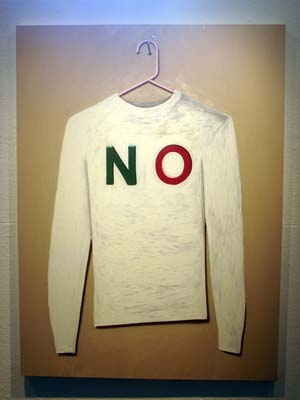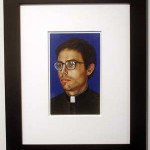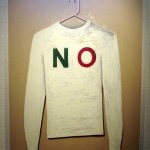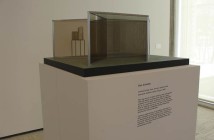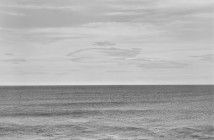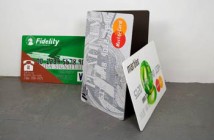The 13 artworks that comprise Matthew Cerletty’s Fallingwater at Boston University’s Sherman Gallery show the artist building on the themes of his earlier realist portraits while engaging in a kind of conceptual figuration. His previous figurative work often depicted friends and family seemingly engulfed by their richly patterned domestic environments, their bodies in ambiguous conflict with their extragent, yet ultimately banal, middle-class surroundings. While a sharp departure in style, the new works lend a greater perspective on his past output. Cerletty’s interest is always with figuration and the body, and in his new work, he concerns himself with a conflation of corporeality with the signs and norms projected onto it. The works in Fallingwater (titled after Frank Lloyd Wright’s masterpiece), articulate a certain anxiety around the body’s relationship to the ideals and messages disseminated by a normalizing popular culture.
In No (2005), Cerletty paints in oil a sweater hung on a hanger and nail. While the hanger and nail displays the same trompe l’oeil realism one has come to expect of the artist, the sweater is painted with thick oil and a build-up of impasto brushstrokes. On the sweater is painted NO, in capital letters. A tension is set up between the realism yet artificiality of the trompe l’oeil hanger and the materiality of the more abstract sweater. The NO written across the chest of the sweater (and across the surface of painting) suggests a refusal of either state, the painting existing awkwardly between the poles of the artificial and the material. Cerletty works consistently within this dialectic, its resulting synthesis creating a sense of pathos and indetermination. Someone’s body, alluded to via the sweater waiting to be worn, is evident only in its absence.
It is this kind of creeping figuration, one alluded to yet not entirely there, that emerges as the focus of the exhibition. In Priest (2006), Cerletty draws himself as a priest. With strong glare reflected in his glasses and staring half dazed at something outside of the picture’s frame, Cerletty allows the viewer a privileged position in their viewing of the priest. Usually a symbol of authority, patriarchy, and the pure or ideal body, here Cerletty’s priest is subject to projection and the privileged position of the spectator who can gaze at him as he looks off at something outside the frame. In this self-portrait, Cerletty situates his own body as the ideal (however awkward and fictional) if only to foreground the fictionality of the ideal itself. To identify or draw himself as a priest means that at a fundamental level he really isn’t one. Cerletty’s Priest makes explicit this fundamental split between the ideal and the actual.
Works like Diet Coke (2006) and I Love Exercise (2006) also speak toward an anxiety of the body while also betraying a sarcastic parroting of popular cultures more insidious messages. Diet Coke, done with thick graphite on paper, starkly focuses the viewers attention on the two terms, Diet and Coke. As one looks at this work, the consistency of the label, “Diet Coke,” is disrupted. A pairing of terms taken for granted in our commodity saturated world is opened up into a contrast of autonomous and maybe contradictory terms, Diet and Coke. I Love Exercise comes across as an empty or disingenuous expression of one’s love for exercise. What is suggested pictorially is more a lack of energy or a kind of slacker ennui than a real genuine enthusiasm for activity. The figure in Untitled (2006) is reduced to an abstracted torso lacking legs and a head. Cerletty focuses us on an isolated yet strange hand gesture. Too high to be a finger on the mouth, it is unclear also where the finger rests on the subject’s temple or points to the forehead. Like the No written across the chest, the priest exposed to the projective interpretations of the viewer, or the media messages parodied in Diet Coke and I Love Exercise, Cerletty’s figure in Untitled is one over-determined by its gesture. In fact, the figure and the free-floating abstract gesture presented to us are one and the same.
In these newer works Cerletty is able to articulate a productive ambivalence about the nature of figuration. While making a brave shift in style, the work further complicates the notion of the figure by not only taking it out of the domestic interiors of his older work but by opening it up to the contradictions and complexities inherent to a figuration over-determined by signs and projection.
Links:
Boston University - Sherman Gallery
Matthew Cerletty
"Matthew Cerletty: Fallingwater" was on view until October 20th at Sherman Gallery at Boston University, 775 Commonwealth Ave., Boston
All images are courtesy of the artist and Sherman Gallery, BU.

